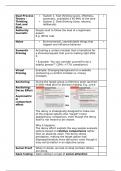Dual Process System 1: Fast thinking (quick, effortless,
Theory – automatic, available) o 95-99% of the time
Thinking System 2: Slow thinking (slow, rational,
Fast and deliberate)
Slow
Authority People tend to follow the lead of a legitimate
heuristic expert.
E.g. White coat
Noise Environmental, unpredictable things that
happen and influence behavior
Semantic Activating a certain mindset that is beneficial for
Priming a stimulus/request that you’re making right after
it.
• Example: “Do you consider yourself to be a
helpful person?” (29%-->77% compliance)
Visual Example: Changing background on a website
Priming (enhancing a comfort mindset vs. money
mindset).
Anchoring Giving the target group a reference point (anchor)
in their head prior to decision making. E.g., price
Anchoring:
Decoy Effect
/
Asymmetric
al
comparison
effect
The decoy is strategically designed to make one
of the original options (the "target") more
appealing by comparison, even though the decoy
itself is not meant to be chosen.
Why it happens:
The decoy effect exploits the way people evaluate
options based on relative comparisons rather
than on absolute value. The decoy skews
perception, making the target option look
disproportionately more attractive, even though it
may not be better in an objective sense.
Social Proof When in doubt, we look at what (similar) others
are doing.
Gaze Cueing Gaze cueing is a type of social attention
, mechanism where people tend to follow the
gaze direction of others. This can happen quickly
and without conscious thought, reflecting an
important aspect of human social cognition.
Symbols of - Expensive stuff (e.g., watches, cars, suits, -
authority etc.)
- Logos on websites (e.g., Visa, PayPal, DHL,
etc.)
Soft (1) Status Quo Bias: (4)
Persuasion People tend to prefer things to remain the
same, seeing any deviation from the
current situation as a potential loss. This is
closely related to loss aversion, where
people fear losing something they already
have more than they value gaining
something new.
(2) Zero Risk Bias:
People have an irrational preference for
options that completely eliminate risk (risk
aversion), even when other options might
provide higher overall benefits but come
with some level of uncertainty.
(3) Reactance Bias:
When people feel their freedom to make
choices is being limited or they’re being
overly influenced, they develop reactance
—a psychological pushback or resistance to
the pressure. Use the evoking freedom
strategy.
Evoking People have an intrinsic desire for autonomy.
Freedom When this sense of freedom is threatened (like
through hard sales tactics or coercion), people
experience something called reactance, a
psychological response where they push back and
resist the pressure to conform or comply. But
don’t name the alternatives). Results in more
trust and likeability. Makes people more inclined
to accept your request.
Persuading How can we get them to show this behavior?
Catalyzing Why aren’t they already doing this by
themselves?
The Catalyst Reactance: Present choices. But: should be
– How to limited
change Endowment: Show the cost of inaction





